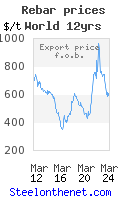Bluefield Coal Show Speech Highlights [BlackDiamond]
Coal Industry Racing to Meet Demand: ; Plant Construction Up, More Investment Seen, Veteran Workers Wanted
BLUEFIELD - There will be a demand during the next few years for every ton of coal central Appalachia can produce, predicts Michael Quillen, president and chief executive of Alpha Natural Resources Inc.
Quillen was one of the speakers at the Bluefield Coal Show, which concluded here on Friday. Here are some highlights from his speech and others.
Quillen said he believes the question isn't whether there's going to be a market for coal but, rather, where is it going to come from.
"You would expect that when the price goes up we would increase the supply and kill the market," he said. The industry is trying to increase supply but the shortage of labor - particularly experienced labor - "is a huge issue," he said.
It's also tough to get new equipment, Quillen said. Most orders are taking a year or longer to fill, he said.
Coal reserves are another supply constraint. "Every ton we mine is a harder ton," he said. "Believe me, no one left the easiest for last."
While a lot of new mines are being developed in central Appalachia, "a whole lot of existing production is going away" as old mines play out, he said.
Quillen said the coal industry's boom-and-bust history makes him hesitant to predict the future, although his company is confident the current boom will last two years. "To say the boom will last seven years is pretty aggressive," he said.
Alpha Natural Resources raised $524.1 million when it went public in February. Foundation Coal Holdings Inc. raised $519 million when it went public in December. Quillen pointed out that 67.5 percent of coal production in the United States now comes from public companies, up from just 34 percent in 1983.
Most of the backing for these public companies has come from private equity firms and hedge funds - "people who were not in the business 24 months ago," Quillen said. Such firms usually invest with a plan to turn a profit and get out. Quillen wondered aloud who will eventually take the place now occupied by the private equity firms and hedge funds. Del Eustace Frederick, D-Mercer, wondered if the oil companies might become involved again, like they were in the 1970s.
Danny Smith, senior vice president of energy and properties at Norfolk Southern, said the railroad is straining to meet the increased demand to haul coal.
Norfolk Southern gets 23 percent of its revenues from coal hauling. "We hauled 10 million more tons last year and this year it will be more than that," Smith said.
Last year Norfolk Southern estimated it would hire 1,800 workers but ended up hiring 2,100. This year the company expects to hire 2,000 workers, he said.
One problem Norfolk Southern has is, about 28 percent of new hires leave within the first two years. Smith said this is especially painful because the company spends about $60,000 to train a new hire.
Another problem is increasing costs. Smith said the rising cost of diesel fuel has had a huge impact on Norfolk Southern and higher steel prices are increasing the costs of locomotives, coal cars and rail.
Mike Mudd, program manager for generation technologies at American Electric Power, explained how his company concluded that building coal-fired plants using a next-generation process known as integrated gasification combined cycle is the best way for it to increase generating capacity.
He said the gasification process offers superior environmental performance. The first few plants will cost more than conventional coal-fired plants but, when mature, the process should provide the lowest capital cost and highest efficiency among coal-based technologies, he said.
In addition to his job at American Electric Power, Mudd is acting chief executive officer of the FutureGen Industrial Alliance. The alliance is a coalition of some of the largest electric utilities and coal companies in the United States. The alliance was formed last week. It plans to partner with the U.S. Department of Energy to help design, construct and operate a next-generation coal-fired power plant called FutureGen.
The big difference between American Electric Power's planned plants and the FutureGen plant is that FutureGen's goal is zero emissions. FutureGen would achieve that goal by pumping carbon dioxide emissions into geologic formations underground.
Mudd said another difference is, American Electric Power wants to build plants that are not risky, since ratepayers will finance them. On the other hand, the idea behind FutureGen is to push the technology by taking risks. "That's why FutureGen is needed," he said.
David Finkenbinder, vice president of congressional affairs at the National Mining Association, said there are 112 coal-fired power plants in various stages of planning.
"There have been more coal-fired plants announced in the last 12 months than over the last 12 years," he said. "Although not all of these will be built, clearly, investment in new coal capacity will be impressive.
"If the opportunity is great, so is the public expectation for cleaner energy," he said.
The coal industry has done much to become cleaner and safer and the recently passed federal energy bill will help it do more, Finkenbinder said. Even so, there much still needs to be done, he said.
Keith Barnett, managing director of fundamental analysis and economic forecasting at American Electric Power, predicted that the price of natural gas will remain linked to the price of oil.
Anybody who thinks the countries that sell us oil are going to sell us natural gas cheap should probably think again, he said.
Barnett noted that many of American Electric Power's plans anticipate that the price of natural gas is going to remain high. If the price of natural gas, now over $10 a million cubic feet, goes back to $3, "our strategy is flawed," he said.
blogger@steelonthenet.com
BLUEFIELD - There will be a demand during the next few years for every ton of coal central Appalachia can produce, predicts Michael Quillen, president and chief executive of Alpha Natural Resources Inc.
Quillen was one of the speakers at the Bluefield Coal Show, which concluded here on Friday. Here are some highlights from his speech and others.
Quillen said he believes the question isn't whether there's going to be a market for coal but, rather, where is it going to come from.
"You would expect that when the price goes up we would increase the supply and kill the market," he said. The industry is trying to increase supply but the shortage of labor - particularly experienced labor - "is a huge issue," he said.
It's also tough to get new equipment, Quillen said. Most orders are taking a year or longer to fill, he said.
Coal reserves are another supply constraint. "Every ton we mine is a harder ton," he said. "Believe me, no one left the easiest for last."
While a lot of new mines are being developed in central Appalachia, "a whole lot of existing production is going away" as old mines play out, he said.
Quillen said the coal industry's boom-and-bust history makes him hesitant to predict the future, although his company is confident the current boom will last two years. "To say the boom will last seven years is pretty aggressive," he said.
Alpha Natural Resources raised $524.1 million when it went public in February. Foundation Coal Holdings Inc. raised $519 million when it went public in December. Quillen pointed out that 67.5 percent of coal production in the United States now comes from public companies, up from just 34 percent in 1983.
Most of the backing for these public companies has come from private equity firms and hedge funds - "people who were not in the business 24 months ago," Quillen said. Such firms usually invest with a plan to turn a profit and get out. Quillen wondered aloud who will eventually take the place now occupied by the private equity firms and hedge funds. Del Eustace Frederick, D-Mercer, wondered if the oil companies might become involved again, like they were in the 1970s.
Danny Smith, senior vice president of energy and properties at Norfolk Southern, said the railroad is straining to meet the increased demand to haul coal.
Norfolk Southern gets 23 percent of its revenues from coal hauling. "We hauled 10 million more tons last year and this year it will be more than that," Smith said.
Last year Norfolk Southern estimated it would hire 1,800 workers but ended up hiring 2,100. This year the company expects to hire 2,000 workers, he said.
One problem Norfolk Southern has is, about 28 percent of new hires leave within the first two years. Smith said this is especially painful because the company spends about $60,000 to train a new hire.
Another problem is increasing costs. Smith said the rising cost of diesel fuel has had a huge impact on Norfolk Southern and higher steel prices are increasing the costs of locomotives, coal cars and rail.
Mike Mudd, program manager for generation technologies at American Electric Power, explained how his company concluded that building coal-fired plants using a next-generation process known as integrated gasification combined cycle is the best way for it to increase generating capacity.
He said the gasification process offers superior environmental performance. The first few plants will cost more than conventional coal-fired plants but, when mature, the process should provide the lowest capital cost and highest efficiency among coal-based technologies, he said.
In addition to his job at American Electric Power, Mudd is acting chief executive officer of the FutureGen Industrial Alliance. The alliance is a coalition of some of the largest electric utilities and coal companies in the United States. The alliance was formed last week. It plans to partner with the U.S. Department of Energy to help design, construct and operate a next-generation coal-fired power plant called FutureGen.
The big difference between American Electric Power's planned plants and the FutureGen plant is that FutureGen's goal is zero emissions. FutureGen would achieve that goal by pumping carbon dioxide emissions into geologic formations underground.
Mudd said another difference is, American Electric Power wants to build plants that are not risky, since ratepayers will finance them. On the other hand, the idea behind FutureGen is to push the technology by taking risks. "That's why FutureGen is needed," he said.
David Finkenbinder, vice president of congressional affairs at the National Mining Association, said there are 112 coal-fired power plants in various stages of planning.
"There have been more coal-fired plants announced in the last 12 months than over the last 12 years," he said. "Although not all of these will be built, clearly, investment in new coal capacity will be impressive.
"If the opportunity is great, so is the public expectation for cleaner energy," he said.
The coal industry has done much to become cleaner and safer and the recently passed federal energy bill will help it do more, Finkenbinder said. Even so, there much still needs to be done, he said.
Keith Barnett, managing director of fundamental analysis and economic forecasting at American Electric Power, predicted that the price of natural gas will remain linked to the price of oil.
Anybody who thinks the countries that sell us oil are going to sell us natural gas cheap should probably think again, he said.
Barnett noted that many of American Electric Power's plans anticipate that the price of natural gas is going to remain high. If the price of natural gas, now over $10 a million cubic feet, goes back to $3, "our strategy is flawed," he said.
blogger@steelonthenet.com




0 Comments:
Post a Comment
<< Home